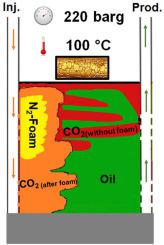International Journal of Greenhouse Gas Control ( IF 4.6 ) Pub Date : 2021-07-01 , DOI: 10.1016/j.ijggc.2021.103392 Jonas Stensbye Solbakken , Morten Gunnar Aarra

|
The high mobility of CO2 in porous media is an issue in most subsurface CO2 projects worldwide, demonstrated by uncontrolled and rapid migration through the reservoir, early well breakthroughs and poor sweep efficiency. Improved mobility control of CO2 is needed to accelerate and improve the value-creation from subsurface CO2 projects, both in terms of energy produced and volumes of CO2 stored. Field-proven conformance and mobility control techniques, such as foam, provide a cost-effective and sustainable alternative to overcome geological and process constraints observed with CO2 flow in reservoirs.
In this laboratory study, we have investigated CO2 mobility control by foam in sandstone core samples at typical North Sea reservoir conditions, 220 barg and 100°C, respectively. Two important aspects related to any field application of foam have been evaluated and discussed: I) Can strong CO2-foams be generated at reservoir conditions using AOS surfactant? If not, II) can relatively simple modifications to the foam system be made to improve foam properties and CO2 mobility control?
Our results show that only high-mobility CO2-foams with low degree of CO2 mobility reduction are obtained at 220 barg and 100°C. An easy way to improve the foam properties at reservoir conditions is suggested by changing the gas-phase in foam to nitrogen (N2). The N2-foams display improved foam generation performance, larger mobility control in terms of mobility reduction factors (MRF) and ability to block subsequent CO2 injection.
An alternative strategy for applying foam for CO2 conformance and mobility control in subsurface CO2 projects, which emerges from this study, is to initiate the foam treatment with nitrogen followed by subsequent CO2 injection to change the main direction of CO2 flow to enhance the displacement area or reduce uncontrolled CO2 production between the injecting and producing wells (as illustrated in the graphical abstract). The possible mechanisms explaining the observed differences in foam properties using CO2 versus N2, including implications that could be helpful for future studies and CO2 field applications are discussed further in more detail.
The efficiency and limitations of miscible CO2 flooding to recover oil and simultaneously store CO2 after extensive water flooding are also demonstrated in this article, which are relevant to enhanced oil recovery (EOR) and subsequent CO2 storage applications, known as the Carbon Capture Utilization and Storage (CCUS).
中文翻译:

在高压和高温条件下使用 N 2泡沫改进CO 2迁移率控制
CO 2在多孔介质中的高流动性是全球大多数地下 CO 2项目中的一个问题,表现为不受控制的快速迁移通过储层、早期井突破和低波及效率。需要改进 CO 2 的流动性控制,以加速和改善地下 CO 2项目的价值创造,无论是在产生的能量还是储存的 CO 2量方面。经现场验证的一致性和流动性控制技术,例如泡沫,提供了一种具有成本效益且可持续的替代方案,以克服在储层中观察到的 CO 2流动的地质和工艺限制。
在本实验室研究中,我们分别研究了在典型的北海油藏条件下(分别为 220 barg 和 100°C)砂岩岩心样品中泡沫对 CO 2流动性的控制。已经评估和讨论了与泡沫的任何现场应用相关的两个重要方面:I) 可以使用 AOS 表面活性剂在油藏条件下产生强 CO 2泡沫吗?如果不是,II) 是否可以对泡沫系统进行相对简单的修改以改善泡沫特性和 CO 2流动性控制?
我们的结果表明,在 220 barg 和 100°C 下只能获得具有低 CO 2迁移率降低程度的高迁移率 CO 2泡沫。通过将泡沫中的气相改变为氮气 (N 2 ),提出了一种在储层条件下改善泡沫特性的简单方法。N 2 -泡沫显示出改进的泡沫生成性能、在流动性降低因子(MRF)方面更大的流动性控制以及阻止随后的CO 2注入的能力。
本研究中出现的在地下 CO 2项目中应用泡沫进行 CO 2一致性和流动性控制的另一种策略是用氮气启动泡沫处理,随后注入CO 2以改变 CO 2流动的主要方向,以提高置换区域或减少注入井和生产井之间不受控制的 CO 2产量(如图形摘要所示)。解释使用 CO 2与 N 2观察到的泡沫特性差异的可能机制,包括可能有助于未来研究和 CO 2 的含义 更详细地讨论了现场应用。
本文还展示了混相 CO 2驱油在广泛水驱后回收油并同时储存 CO 2的效率和局限性,这与提高石油采收率 (EOR) 和随后的 CO 2储存应用有关,称为碳捕集利用和存储 (CCUS)。











































 京公网安备 11010802027423号
京公网安备 11010802027423号